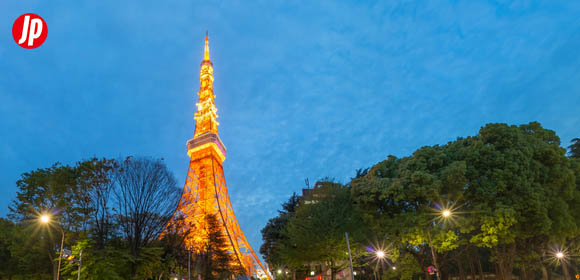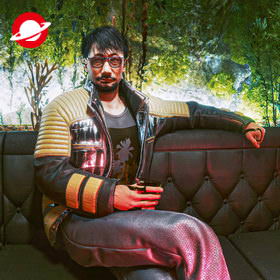
Tokyo, the capital of Japan, is located in the middle of Honshu Island and is the political, economic and cultural center of Japan. Tokyo is the most popular tourist destination in Japan, with unforgettable landmarks such as the Tokyo Tower and the Tokyo Skytree. Not far from the Imperial Palace, there are many famous business districts and sub-centers such as Ginza, Shinjuku, Shibuya and Odaiba.
Landmarks of Tokyo
The red-and-white Tokyo Tower was built in 1958 and stands 333 meters tall, in the shape of the Eiffel Tower in Paris. Since its construction, it was the tallest building in Tokyo until 2012, when it was surpassed by the next-generation landmark, the Tokyo Skytree.

Tokyo Tower
Symbolic Landmark of Tokyo
For more than half a century, the Tokyo Tower has been considered a landmark of Tokyo. Modeled after the Eiffel Tower in Paris, the 333-meter-high Tokyo Tower has two viewing platforms at 150 and 250 meters above sea level, offering panoramic views of the city.
As the central hub of Japan’s transportation network, Tokyo Station is home to dozens of rail lines covering major cities in Japan, from Hokkaido to Kyushu. The Marunouchi (丸ノ内) exit of Tokyo Station, built in 1914, is a century-old red brick building.

Tokyo Station
Century Old Red Brick Building
Tokyo Station is located in the heart of Tokyo city, and its Marunouchi Entrance is a century-old red brick building, one of the city's landmarks. Tokyo Station is served by many high-speed rail lines and regional commuter lines, connecting all major Japanese cities from Hokkaido to Kyushu.
Located in the old downtown area of Tokyo, Senso-ji Temple attracts attention for its t religious culture, and every day the shopping streets of Kaminarimon (雷門, “Thunder Gate”) and Nakamise-Dori are jammed with tourists from all over the world.

Sensoji Temple
Asuka Period Ancient Temple
Senso-ji Temple is the oldest temple in Tokyo and is dedicated to the Asakusa Kannon. The giant red lantern at the Thunder Gate is the symbol of the temple, and the 250-meter-long Nakamise Shopping Street is packed with nearly 100 shops selling a variety of Japanese food and souvenirs.
Tokyo Subcenters
Tokyo has one of the largest populations in the world, and a single urban core cannot meet the demand of such a dense urban population. Tokyo’s sub-centers of Shinjuku (新宿), Shibuya (渋谷), and Odaiba (お台場) have gradually formed, and together with Tokyo’s neighboring prefectures of Saitama, Chiba, and Kanagawa, they form Japan’s capital metropolitan area.

Shinjuku
Secondary City Center of Tokyo
Shinjuku is known as the sub-center of Tokyo and is one of the busiest business districts in the city. Shinjuku is home to many government and corporate buildings, including the Tokyo Metropolitan Government Building and many skyscrapers over 200 meters tall, and the Kabukicho district east of Shinjuku Station attracts a large number of tourists.

Shibuya
World's Busiest Pedestrian Crossing
Shibuya is one of the most crowded commercial districts in Tokyo, with commercial centers such as Shibuya 109, Hikarie, and QFront, which are popular with young people. The intersection in front of Shibuya Station is a spectacular place to walk through, and the statue of the Faithful Dog Hachiko is the symbol of Shibuya.

Odaiba
Reclaimed Modern Seafront District
Odaiba is an artificial continent reclaimed from the sea in Tokyo Bay, Japan. The Odaiba area is popular among young people in Japan for its natural beauty, sea views, and modern shopping and entertainment facilities.
Manywhere Trivia:
Theoretically, there is no such thing as the “City of Tokyo”, only the concept of “Tokyo Metropolis”, which is a higher level than city and the same level as Japan’s prefectures. Tokyo and the surrounding prefectures are collectively known as the “Tokyo Metropolitan Area”, but it is still not clearly defined by law what the capital of Japan is.
World-class Shopping Districts
Tokyo has a spending power that most cities can only dream of, and the Ginza (銀座), Akihabara (秋葉原), and Roppongi Hills (六本木ヒルズ) business districts each have their own characteristics and target groups. Ginza is one of Tokyo’s oldest commercial districts, everything in this area exudes a sense of elegance and luxury. Akihabara, which started out as an electrical appliance retailer, is now regarded as the heaven of ACG (Anime, Comics and Games).

Ginza Tokyo
World's Top Shopping District
Tokyo's Ginza, one of the world's top three business districts, has always been home to the highest concentration of high-end and luxury brands. The streets of Ginza are filled with stores of major global luxury brands, as well as upscale local shopping centers such as Wako Department Store, Mitsukoshi Department Store and Matsuya Ginza.

Akihabara
Pop Culture Paradise
Akihabara is known as a heaven for anime fans. It emerged after World War II, from radios, to later TVs and refrigerators. To this day, you can find any digital and electrical product you want in Akihabara, hence the name Akihabara Electric Town.

Tsukiji Market
World's Largest Seafood Feast
Tokyo's Tsukiji Market, claimed to be the best in Japan, is home to fresh seafood ingredients and is visited by countless wholesalers every day. The Tsukiji Market is open to tourists, too, and has a variety of well-known sushi restaurants and vendors to satisfy the needs of foodies.

Roppongi Hills
Landmark Commercial Complex
As a modern commercial complex that took 17 years to complete, Roppongi Hills combines shopping, residential, entertainment and gourmet functions. The area is home to the Mori Tower, a 238-meter-high landmark, as well as the Mori Garden, Asahi TV, Grand Hyatt Hotel and Toho Cinema.
Cherry Blossoms in Tokyo
The cherry blossom season is the busiest time in Tokyo, and it’s hard to find a hotel room then. There are many famous cherry blossom spots in Tokyo, such as Ueno Park, Chidorigafuchi (千鳥ヶ淵) outside the Imperial Palace, and Meguro River (目黒川), which is famous for its nighttime cherry blossoms.

Ueno Park
Japan's First Park
Ueno Park is the first park in Japan with more than 50 different types of cherry trees existing in the park. Every year during the cherry blossom season, the park is jam-packed with tourists. Ueno Park is also home to the Ueno Zoo, Ueno Toshogu Shrine, museums, art galleries, and other attractions.

Chidoriga-fuchi Park
Cherry Blossoms by Imperial Palace
The moat outside the Imperial Palace is lined with cherry trees and is a famous cherry blossom viewing spot in Tokyo, named Chidorigafuchi because the water resembles a flying bird. From March to April every year, hundreds of cherry trees on both sides of the Chidorigafuchi moat are in full bloom, attracting visitors from all over the world.

Meguro River
Iconic Night Cherry Blossoms
Meguro River is an urban waterway in Meguro, Tokyo, with about 800 cherry trees planted on both sides of the 4-kilometer waterway. The Meguro River is famous for its night cherry blossoms and is visited by many visitors from March to April when the cherry blossoms are in full bloom.


































